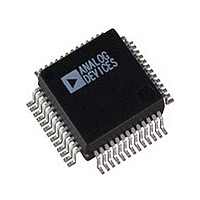AD7339BS Analog Devices Inc, AD7339BS Datasheet - Page 11

AD7339BS
Manufacturer Part Number
AD7339BS
Description
IC ADC/QUAD DAC 5V W/REF 52-MQFP
Manufacturer
Analog Devices Inc
Type
ADC, DACr
Datasheet
1.AD7339BS.pdf
(12 pages)
Specifications of AD7339BS
Rohs Status
RoHS non-compliant
Resolution (bits)
8 b
Sampling Rate (per Second)
2M
Data Interface
Serial, Parallel
Voltage Supply Source
Analog and Digital
Voltage - Supply
5V
Operating Temperature
-40°C ~ 85°C
Mounting Type
Surface Mount
Package / Case
52-MQFP, 52-PQFP
Converter Type
ADC/DAC
Resolution
8b
Number Of Dac's
4
Data Rate
2.304MSPS
Digital Interface Type
Parallel/Serial
Pin Count
52
Package Type
MQFP
Lead Free Status / Rohs Status
Not Compliant
Available stocks
Company
Part Number
Manufacturer
Quantity
Price
Part Number:
AD7339BS
Manufacturer:
ADI/亚德诺
Quantity:
20 000
Company:
Part Number:
AD7339BSZ-REEL
Manufacturer:
Analog Devices Inc
Quantity:
10 000
TERMINOLOGY
Differential Nonlinearity
The difference between the measured and the ideal 1 LSB change
between any two adjacent codes in the ADC or DACs. A speci-
fied Differential Nonlinearity of 1 LSB max over the operating
temperature range ensures monotonicity.
Integral Nonlinearity
The maximum deviation of any code from a straight line passing
through the endpoints of the transfer function. The endpoints
of the transfer function are zero scale, a point 0.5 LSB below the
first code transition (000 . . . 00 to 000 . . . 01) and full scale, a
point 0.5 LSB above the last code transition (111 . . . 10 to
111 . . . 11). The error is expressed in LSBs.
Signal to (Noise + Distortion)
Signal to (Noise + Distortion) is measured signal-to-noise at the
output of the ADC. The signal is the rms magnitude of the
fundamental. Noise is the rms sum of all nonfundamental sig-
nals up to half the sampling frequency (F
Signal to (Noise + Distortion) is dependent on the number of
quantization levels used in the digitization process; the more
levels, the smaller the quantization noise. The theoretical signal
to (Noise + Distortion) ratio for a sine wave signal is given by
where N is the number of bits. Thus for an ideal 8-bit converter,
Signal to (Noise + Distortion) is 49.92 dB.
ADC
Effective Number of Bits (ENOB)
Signal to (Noise + Distortion) is expressed in dBs; rewriting the
Signal to (Noise + Distortion) formula, it is possible to get a
measure of performance expressed in effective number of bits.
The effective number of bits for a device can be calculated di-
rectly from its measured Signal to (Noise + Distortion) value.
where SNR is the Signal to (Noise + Distortion).
Zero Input Offset Error
This is the offset error in the ADC when the analog input is
zero. Ideally, the digital output should equal 100 . . . 00. The
offset error is the deviation from the ideal output code. The
offset error is expressed in LSBs.
Intermodulation Distortion
With inputs consisting of sine waves at two frequencies, fa and
fb, any active device with nonlinearities will create distortion
REV. 0
Signal to (Noise + Distortion) = (6.02N + 1.76) dB
ENOB = (SNR – 1.76)/6.02
S
/2) excluding dc.
–11–
products, of order (m + n), at sum and difference frequencies
of mfa
terms are those for which m or n is not equal to zero. For the
AD7339, the Intermodulation Distortion is the level to which
the second and third intermodulation terms are suppressed
below a full scale output signal level, the second order terms
being (fa + fb) and (fa – fb) while the third order terms are
(2fa + fb), (2fa – fb), (fa + 2fb) and (fa – 2fb).
Error Rate
The rate at which A-to-D conversion errors occur.
DACS
Bipolar Zero Offset Error
The deviation between the measured output voltage and the
bias voltage (VREFA or VREFB, depending on which DAC is
being tested) when the DAC is loaded with code 100 . . . 00
after gain error has been adjusted out.
Gain Error
A measure of the output error between an ideal DAC and the
actual device output with all 1s loaded after offset error has been
adjusted out.
Update Rate
The rate at which the DACs can be loaded with new data. The
parallel DACs have an update rate of 2.304 MHz while the
serial DACs have an update rate of 256/10 kHz maximum.
Gain Matching Between DACs
The matching between the analog output amplitudes of the
parallel DACs when the same digital word is written to each
DAC.
Crosstalk
The ratio of the amplitude of a full-scale signal appearing on
one channel to the amplitude of the same signal which couples
onto another channel. Crosstalk is expressed in dBs.
Output Harmonic Content
When the digital word is converted to analog form, harmonics
will also be generated. The Output Harmonic Content specifies
the amount by which these harmonics are attenuated relative to
the fundamental frequency. With the parallel DACs, a full sine
wave of frequency 0 kHz to 128 kHz is input. The resulting
analog output is evaluated and the amount by which the
harmonics in the frequency band 0 MHz to 1.1152 MHz are
attenuated is measured relative to the magnitude of the fun-
damental output signal.
nfb, where m, n = 0, 1, 2, 3, . . .. Intermodulation
AD7339





